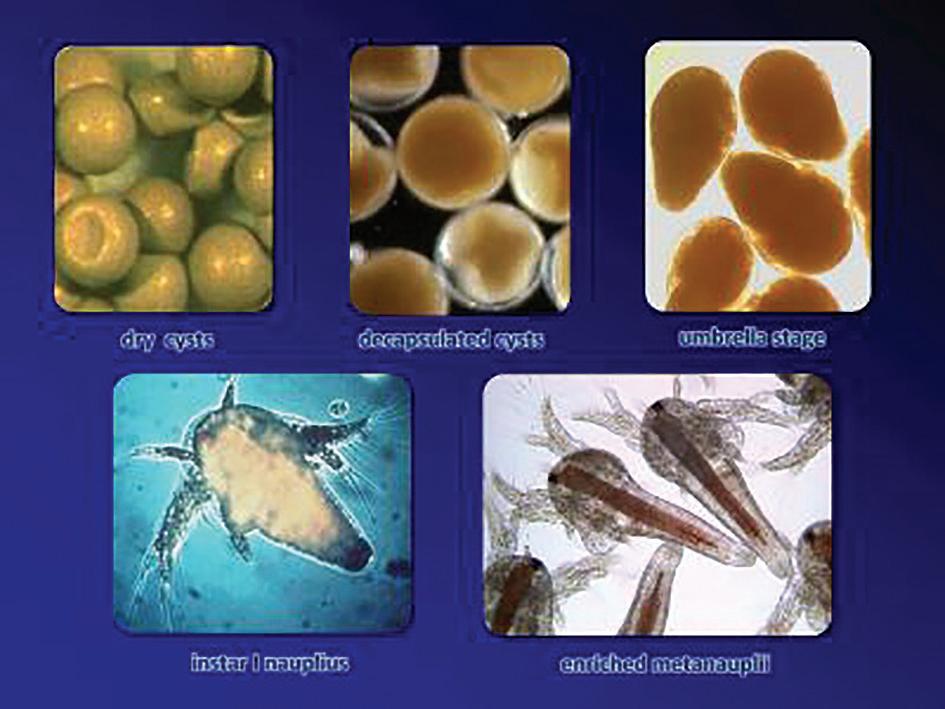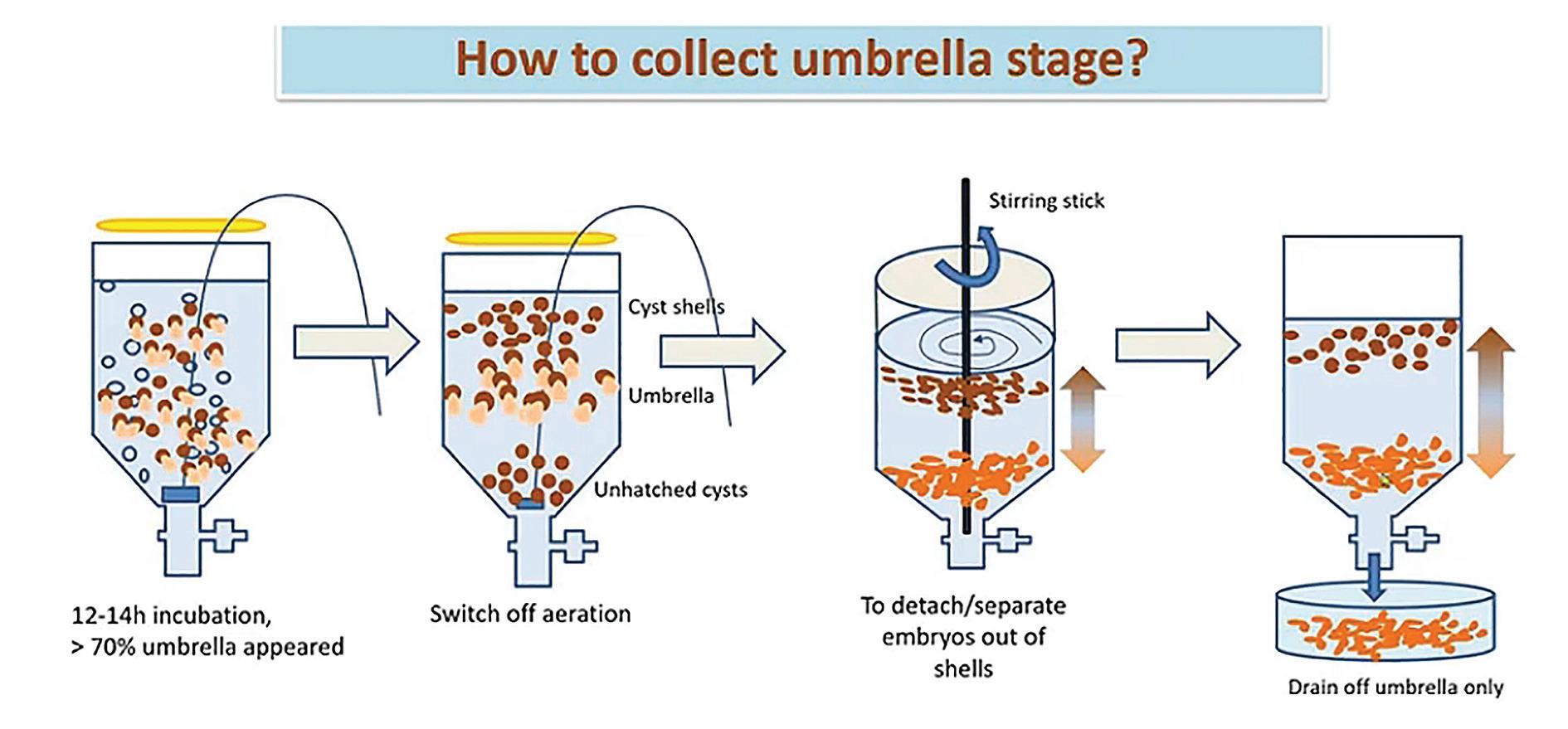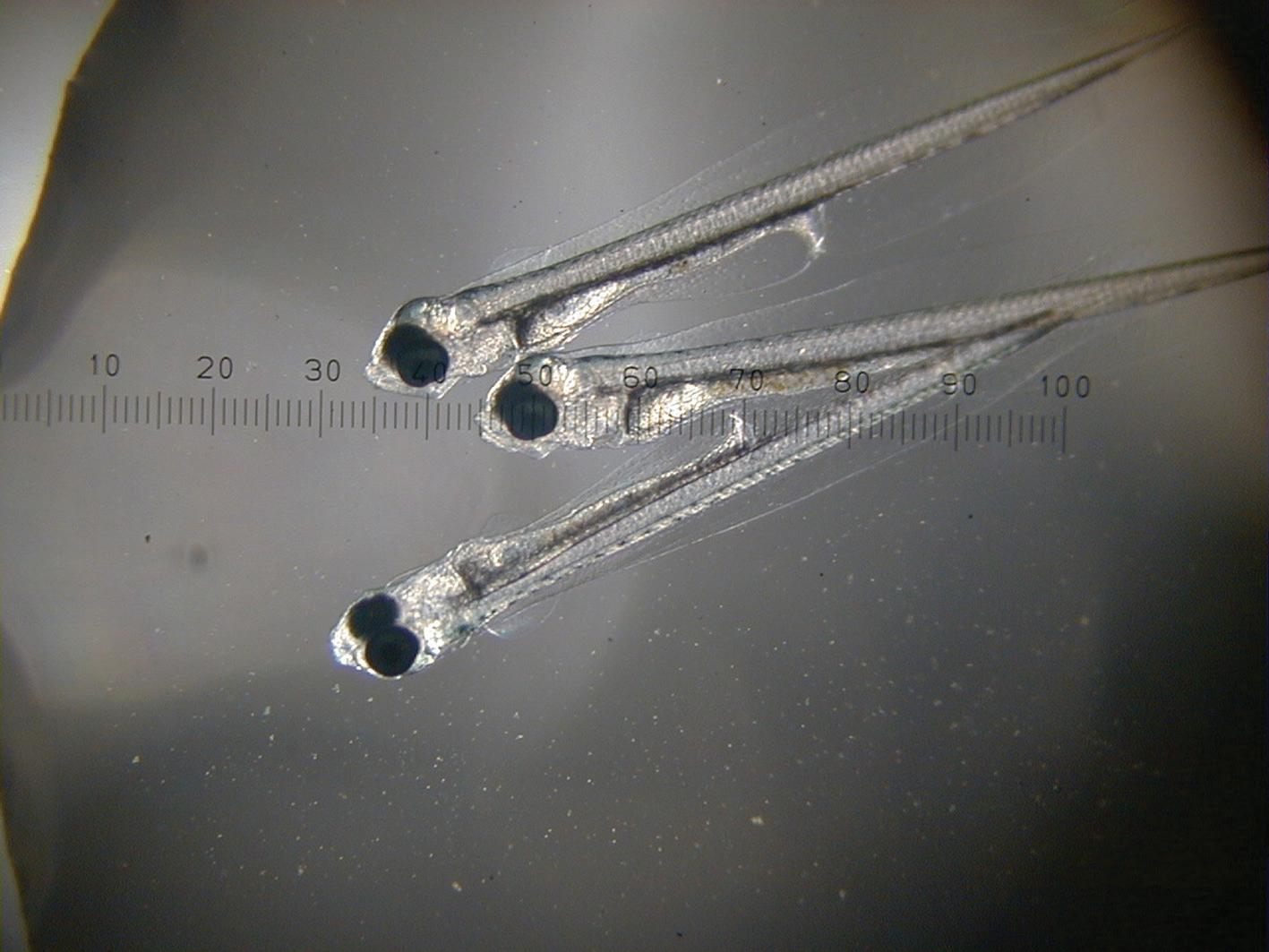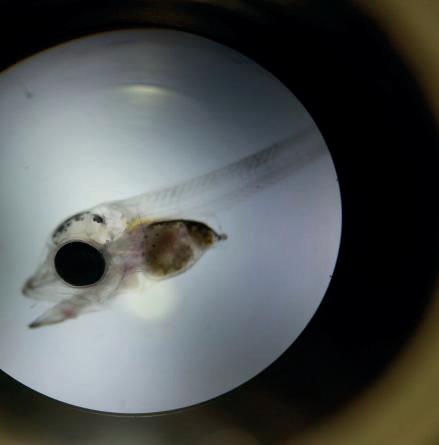
17 minute read
Status of Artemia cysts use and its future sustainable production
With the expansion of hatchery production, the demand for Artemia cysts has continued to increase. Annual consumption is now estimated at 3,500-4,000 tonnes, underpinning the production of over 900 billion crustacean postlarvae and fish fry by a hatchery industry valued at more than USD 2 billion, and the final production of over 10 million tonnes of high-value aquaculture species.
In the 1960s, two companies in the U.S. started marketing Artemia cysts collected from the salt ponds in San Francisco Bay, California, and the Great Salt Lake, Utah. As of the 1960s, different research institutes developed the first hatchery protocols with Artemia nauplii as a crucial live food source, initially in Japan with Japanese seabream and kuruma shrimp and soon thereafter in other parts of the world with other fish, shrimp and prawn species.
Despite initial concerns on Artemia production costs and availability, confidence increased with improved Artemia production techniques. With the creation of the Artemia Reference Center in 1978 at Ghent University and with an international interdisciplinary approach, experts in Europe and the Americas addressed several issues, such as processing cyst techniques, hatching process, storage, etc.
As of the 1980s, and especially in the 1990s, the commercial hatchery industry experienced a boom, particularly with marine shrimp aquaculture growth in Latin America and Asia, and with marine fish in Asia and Europe. Annual Artemia cyst consumption increased from less than 100 tonnes in the 1980s to over 2,000 tonnes by the turn of the century.
Currently, commercially available cysts are harvested from the Great Salt Lake in North America, from several large salt lakes and coastal salt works in Asia, and from controlled production (but still in moderate quantities) in seasonal salt works in Southeast Asia.
As has happened with several lakes in the past decade, inland salt lakes are under constant threat of
Photo credit: Artemia Reference Center, Ghent University, Belgium.
drying up, and with climate change, this situation could only worsen in the future. With approximately 90% of the current Artemia production harvested from inland salt lakes, the future of the hatchery industry could be at risk and requires urgent attention. To address these issues, two workshops took place in September 2021, organized by Ghent University’s Artemia Reference Center, the Network of Aquaculture Centers in Asia-Pacific, the Artemia Association of China and the Asian Regional Artemia Reference Center, to explore needs and opportunities for a new international initiative to guarantee a more sustainable provision of Artemia.
Artemia use around the world
Experts presented differences in practices in the use of Artemia cysts by fish and crustacean hatcheries in different countries.
China
China has the world’s largest market demand for Artemia. The country annually consumes 1,700 MT of dry Artemia products (50% of global production)

Dry Artemia hatching and harvesting process in Thailand, presented by Montakan Tamtin, director of the Samut Sakhon Coastal Aquaculture Research and Development Center, from the Department of Fisheries in Thailand.
of which 76% are for shrimp hatcheries, 15% for Macrobrachium and 9% for marine fish.
In China, there are specific demands for Artemia cysts from different origins. Marine fish larvae need Artemia with better separation of the nauplii from the shell, such as Tibet and Ebiet cysts, and Macrobrachium larvae prefer faster swimming Artemia nauplii, such as BHB cysts. Artemia cysts with higher hatching temperature tolerant cysts are preferred in the summer in Hainan Province and lower hatching tolerant salinity cysts are preferred in regions with low-salinity seawater (1%) in certain seasons.
Hatching facilities and techniques have been significantly improved in recent years. Some hatcheries have their own Artemia facilities following standard procedures. To facilitate shell separation, at the end of the hatching period, light and aeration are turned off and a separation powder is added (H2O2 or sodium percarbonate, 5 ppm). After ten minutes, shells and nauplii are separated.
Artemia nauplii hatcheries are a new business model that produces Artemia by a specialized company near the hatcheries. It started in 2005 in the south and currently operates all over China. These companies annually produce 5001,000 MT nauplii biomass, accounting for 50-80% of the total nauplii demand in China. This Artemia is sold fresh or frozen.
China is also a producer of Artemia cysts. The country annually harvests 800-1,200 MT of dry cysts, but still has to import from other countries, such as Russia, Kazakhstan and Uzbekistan, to fit the country’s demand. The country also exports 400-600 MT of dry Artemia.
Other types of Artemia used in the hatcheries are decapsulated Artemia cysts and Artemia biomass (100,000 MT harvested annually).
Thailand
With 468 shrimp hatcheries and nurseries in 2019, the country has an estimated annual shrimp production of 66.58 billion Nauplii and 33 billion PLs. Thailand imported 634 tonnes of Artemia cysts in 2019 and 482 tonnes in 2020, 90% from China, Russia, Uzbekistan and Kazakhstan and 10% from the U.S., according to the Fish Import and Export Control Group.
Dried Artemia cysts are used following the traditional protocol harvesting Instar I or enriched Instar II. Chilled Instar I and II are also available in the market providing more quality and quantity consistency. Raw Artemia cysts are also used, as well as shell-free Artemia cysts. Shell-free Artemia cysts are 30-40% cheaper than standard Artemia cysts and are used to feed PL5 onward.
In the past for the production of Penaeus monodon selling at PL 15-16, enrichment techniques were

Incubation process of Artemia umbrella stage presented by Nguyen Van Hoa from CanTho University.
used, but currently, enrichment is considered not necessary for Litopenaeus vannamei selling at PL10. Some farms do a short enrichment adding vitamins and lipid emulsions.
Large-scale hatcheries use 90-100% of chilled Artemia Instar I&II and 10% of traditional dry Artemia cysts and medium-scale hatcheries use 40% of chilled and 60% of traditional cysts, or 100% traditional dry Artemia cysts in most eastern hatcheries. Small-scale hatcheries use 100% traditional dry Artemia cysts.
Asian seabass hatcheries rarely use Artemia since they use zooplankton from earthen ponds to reduce production costs. ppm) and/or bacteriophages (5-10 ppm) or povidoneiodine (20-30 ppm) are used to reduce and control the bacteria loads.
For zoea and mysis stages, inactivated Instar I is preferred, using frozen nauplii (frozen for 6-8 hours before feeding the larvae) or heat-inactivated nauplii (boiled).
Temperature is the most challenging parameter due to the high fluctuations between day and night, especially in winter, and as its control is too expensive for Indian hatcheries. The lack of light and pH control also affects the Artemia hatching output, as well as Vibrio contaminations and the lack of skilled labor.
India
In India, there are 401 shrimp hatcheries with a total PL production in 2020 of 70 billion. The country estimated Artemia consumption in 2020 was 325-345 MT with the U.S. as the main sourcing country. The average Artemia consumption per million PL produced is 3.8 kg. The country uses GSL Artemia following the standard procedures. Enrichment is sometimes used with micro-nutrients for frozen Artemia.
Probiotics (5-20 ppm), chlorine dioxide (2-5 ppm), or ozone (300-350 ORP) are applied during hatching to reduce the bacteria load, also improving the hatching rate by 2-5%. For nauplii, probiotics (10-20
Vietnam
Artemia cysts in the Mekong Delta in Vietnam are mainly imported from the U.S., Russia and China. The country has a small production of Vihnchau Artemia that does not meet the country’s consumption. Hatcheries use dry cysts following the standard protocol. For large-scale operations, chilled Instar I&II are also available.
A recent innovation developed in the country was the replacement of rotifer with Artemia umbrella stage in zoea stages of mud crab larvae. The replacement was made with the small Vinhchau Artemia strain. To get the umbrella stage, the same incubation process as the standard protocol is followed for 12-14 hours. At this
time, <70% of the umbrella stage appear. Aeration is stopped and a stirring stick is used to separate embryos from shells and harvest the umbrella Artemia.
Viet-Uc, the world’s largest shrimp hatchery, built its first shrimp hatchery in 2001 and now operates nine shrimp hatchery units that supply 15-20 billion postlarvae per year with an Artemia consumption of 60-80 tons per year, hatching 30-100 kg of Artemia per day. The company uses Artemia dry cysts and has upgraded its Artemia production facilities to reach this production implementing room temperature and light control, larger hatching tanks and pH control.
Bangladesh
The number of monodon shrimp and prawn (Macrobrachium) hatcheries in operation in Bangladesh in 2021 were 56 and 6, respectively. The number of PL produced per year was 10-14 billion shrimp and 30 million prawn and the amount of Artemia cysts required per year was 50 MT.
The country uses Artemia dry cysts following different procedures close to the standard procedures, but that require improvements for better hatchery management. Nauplii disinfection treatments used before feeding larvae are chloramine-T, formalin, antibiotics, probiotics and C vitamin.
In 2020, an EU-funded Artemia project (Artemia4Bangladesh) successfully locally produced Artemia cysts and biomass with the aim to reduce import dependency and open the scope for increased income of salt farmers.
Europe
Mediterranean marine fish hatcheries hatch and harvest Artemia in their own facilities with full control of the rearing parameters. They were the first to adopt cold storage of Artemia nauplii and now use milk storage tanks. The technique of cold storage needs to receive much more attention as it allows to keep the Artemia under the most nutritious condition for a prolonged time, while making the production of Artemia less labor intensive as the hatching of the cysts can be concentrated in a more limited period using the resources in a more efficient way. Furthermore, live Artemia storage also allows more frequent feeding of the fish/shrimp larvae, eventually with automatic pumping devices.
Artemia consumption for seabass and seabream in a Mediterranean commercial hatchery (Avramar) is around 50 kg of Artemia cysts per million fish produced and 100 kg for meagre, since it is fastergrowing species.
Ecuador
In Ecuador, 386 shrimp hatcheries produce 159,479 million Nauplii and 79,739 million PLs. The country imported 194,331 kg of Artemia cysts in 2020, 60% from Russia and 40% from the U.S.
The hatching procedures do not monitor the main hatching and rearing parameters. Most of the Artemia cysts (98%) are decapsulated and 2% of hatcheries use direct incubation.
Peroxide or brine salt solutions are added to the hatching tank for cyst shell separation. Nauplii can be disinfected with formalin (10 ppm) or hydrogen peroxide (50 ppm). Freshly harvested and disinfected Artemia nauplii are seldom offered to shrimp larvae but they can also be frozen in plastic bags, or heated (dipping in hot water) and then frozen for later use. Heating Artemia might kill Vibrios but also damage the nauplii.
Recommendations
Over time, the practices used by hatcheries in Asia, Europe and Latin America have diverged from the good aquaculture practices for Artemia production recommended by FAO’s 1996 live food manual. There is room for improvement in optimizing the use of Artemia cysts in aquaculture hatcheries, and this should result not only in economizing its use but especially offering a highly nutritional and Vibrio-free food to the baby fish/crustaceans.
To guarantee a more sustainable provision of Artemia, both from natural sources and from controlled extractive Artemia farming integrated with salt production and other fish/crustacean aquaculture, the workshop made the following specific recommendations: • Develop improved guidelines for biosecure production and use of Artemia in hatcheries, including an update of the FAO Artemia manual and convene regional
Artemia training courses for local hatcheries, to disseminate good practices and facilitate the adoption of standardized protocols.
• In view of the large variety of species and strains of
Artemia that are now available in the market, their specific characteristics should be studied to identify their most suitable application for specific species of fish and crustaceans. This could relate to their nutritional composition, synchrony in hatching or enrichment characteristics. • Initiate strain selection and selective breeding to develop improved Artemia strains for aquaculture applications, noting the availability of the Artemia genome. • Investigate the use of umbrella Artemia as successfully applied in the Vietnamese crab hatcheries for wider application in aquaculture, as a new source of live food in earlier larval stages, be it for shrimp or in fish. • Reconsider a wider use of Artemia enrichment techniques in hatcheries, as it is now restricted to applications in marine fish and crab production.
This method not only allows enhancement of the nutritional value of the nauplii but can also be used as a vector to deliver, for example, pre- or probiotics to the larvae. • Investigate the impact of climate change on Artemia production in inland lakes and coastal saltworks. • Develop science-based protocols to assure sustainable harvesting of wild Artemia sources, especially in central Asia. • Conserve Artemia biodiversity through means such as cyst banks, species identification, “wild” vs “farmed” species, genotyping and strain characterization. • Investigate integration of extractive Artemia farming with intensive fish/crustacean aquaculture. • Investigate the use of Artemia biomass as high-value protein ingredient in human diets. • Consider integration of Artemia production in artisanal salt farming in Asia and Africa, desert/arid and salt-affected areas. An International Artemia Aquaculture Consortium (IAAC) is planned to be launched soon for further improvements.
References
FAO, 2021. FAO Aquaculture News. No. 63 (May). Rome. NACA Newsletter, January-March 2022, Vol XXXVII, No. 1. Status of Artemia cyst use in fish and crustaceans hatcheries around the world webinar. SDG-aligned Artemia Aquaculture Workshop.
Developments in marine fish hatcheries
Gidon Minkoff
Gidon Minkoff operates consulting services for the hatchery sector at Fish Hatchery Consulting. E: gminkoff@gmail.com
Dry food or live food for larval first feeding

The manager of the fish hatchery where I was first employed had previously worked for a company that was developing a dry feed for substituting live feed. That was (can I say this) in 1987. That diet never materialized. Since then a considerable effort has been invested into developing hatchery diets. This has resulted in a range of feeds for co-feeding larvae alongside live feed, as well as reducing the live feed stage through early weaning. However, eliminating live feed through commercial substitutes has not yet happened.
Over the years, and to support the development of the hatchery industry, a very significant body of literature on feeding and nutrition in fish larvae has been generated. The development of visual, locomotory and digestion systems, as well as specific nutritional requirements for fish produced in our hatcheries on a massive scale, have been well described and there are excellent reviews that are easily accessible (Zambonino Infante et al., 2008; Rønnestad et al., 2013). This short column will examine some of the major issues that have impeded the development of inert firstfeeding diets.
The world of fish is extremely diverse, and in the diverse water habitats fish have developed a range of specific adaptations. The subject of this column is those fish that are raised in our hatcheries, larvae that hatch from small floating eggs, hatch with a yolk sac and start feeding on small zooplankton. The academics call them “altricial larvae”. For such a larva to start feeding, an artificial diet would need to have the specific attributes that will elicit a feeding response, be small enough for the larvae to swallow, digestible, and contain all the nutrients that the larva needs for its development.

Larvae of sablefish (Anoplopoma fimbria) first feeding on rotifers.
The technical process for producing a small particulate diet in the size range 60-150 µm is well established. However, providing a complete nutrient pack at this size range, from which the nutrients will not leach until it is eaten by the larvae, which could take a couple of hours, has yet to be resolved.
Larvae feeding is elicited through visual cues which is why eye pigmentation develops prior to first feeding. Light is essential for developing feeding behavior. On top of that, we also know that the larvae are attracted by the movement of their food in the water. Zooplankton actively moves and maintains itself in the water column. Inert diets on the other hand tend to sink, albeit slowly. Although it is possible to keep diets in suspension through aeration and water currents, these same currents also move the larvae and impede them from focusing, homing in and capturing their prey in one single lunge.
Things get even more complicated once the feed passes through the esophagus and into the digestive
tract. The digestive tract of the larvae at first feeding is very delicate, a tube that is constructed from a single layer of cells (epithelium) that make up the inner coating of the tube which are held together by a diffuse connective tissue. This tube is then surrounded by a layer of muscle cells that work to move the food backward through the digestive tract.
Fish do not have salivary glands that will soften and initiate the digestion of food. Instead, they have cells that release a mucus substance that protects the epithelial cells from abrasion by the food. The number of these cells and the secretion of mucus-like substances at first feeding is very low.
All this histological evidence indicates that a dry diet at this stage for replacing live food would need to be very soft and lack any sharp edges. Otherwise, its physical effect on the digestive tract would be like that of sandpaper, irritating and destroying those delicate epithelial cells.
Once the food particle is caught and ingested it needs to be digested. Marine fish larvae at start feeding do not have a functional stomach. Stomach development only takes place towards the end of the larval phase. Once the stomach develops and acid secretion takes place then, within the acidic medium that is created in the stomach, pepsin is released and the larvae acquire the capacity to break down complex proteins into short peptides and amino acids.
But at start feeding, in the absence of a stomach, the proteins are broken into long peptide chains by the enzyme trypsin. While short peptides and amino acids can be directly absorbed from the intestine into the body, the long peptides need to be actively transported into the body by the epithelial cells through a process of pinocytosis. This process is both energetically costly as well as requiring particular cellular structures (membranes) for carrying out the process.
Proteins are the building blocks that the larvae need for both development and fuel. Depending on the species, their weight increase rate is equivalent to 10% and up to 50% body weight per day as the larvae require a lot of protein. Unfortunately, having only trypsin at their disposal, their digestion of proteins is limited. One of the major advantages of zooplankton over inert diets is that they contribute both digested nutrients as well as enzymes that augment the digestion capacity of the larvae.
The search and research for first feeding diets will continue. There is a market for such a product and we prefer “off the shelf” rather than on-site production. Nevertheless, I sometimes wonder if the effort is moving in the right direction. Do we really need to replace rotifers? Rotifers have paved the way to a very successful marine fish farming sector. They are easy to culture in mass, have the ideal size range, are easily digested and can be boosted with the nutrients that are required by the larvae. We could continue using rotifers and possibly, by applying genetic tools, develop rotifer clones that synthesize molecules such as DHA, taurine and others which they are not capable of doing. Venturing into GM rotifers poses an ethical dilemma. However, as rotifers have been a core driver of the marine fish hatchery sector, should we not be improving rather than replacing them?

1 Marine Fish Hatchery Consulting
Bio-technology expertise to design, develop and operate hatcheries for cold and warm water fishes.
Established 25 years ago, Fish-Hatchery-Consulting.com specialises in delivering the entire range of know-how necessary for producing juveniles in hatchery environments. Services include: •Hatchery dimensions and system design •Capital and operating budgets •Production processes and protocols •On-site/off-site technical support •Production analysis
Fish-hatchery-consulting.com
Linkedin.com/in/gidonminkoff










